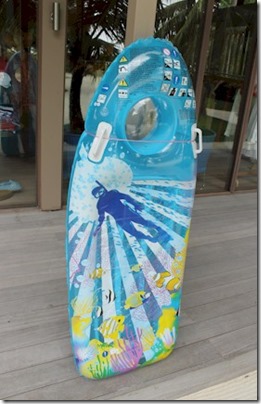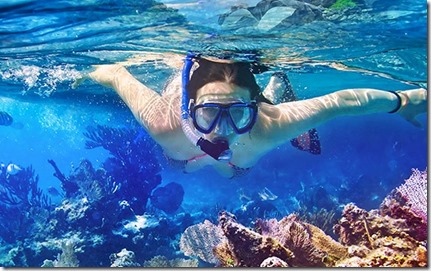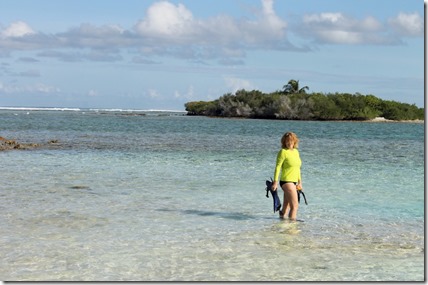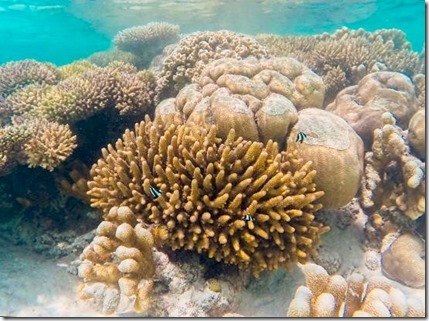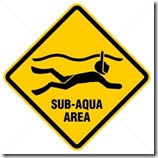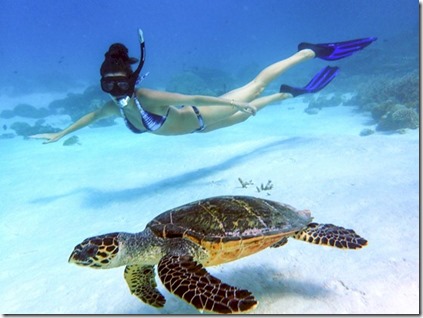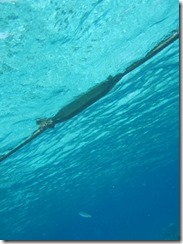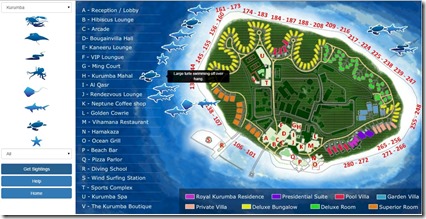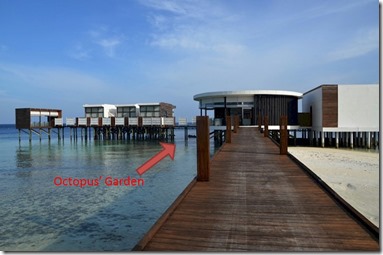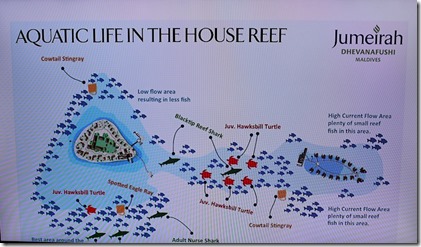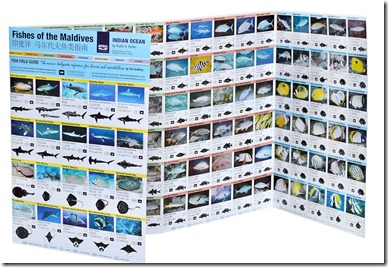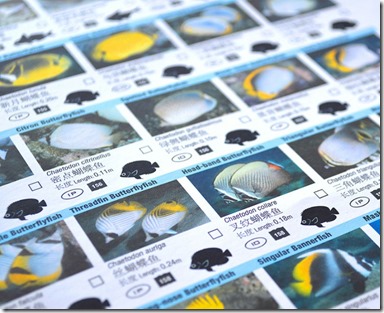With the Christmas shopping season formally launched, the biggest shopping day of the year, “Black Friday”, is upon us. I’m a big snorkelling aficionado, so any gear to help me peer into the aquatic world is always a hit with me. One of the most coveted items I’ve seen is the “Splash and Play” snorkel float by Bestway in Club Med Finolhu’s “The Boutique”. I’ve seen a few resorts offer them for use by guests, but I haven’t seen any you can buy until now. Just perfect for even lazier underwater gazing while soaking up the sun’s rays. Now if I can just get Santa to bring me an airplane ticket to the Maldives…
Best of the Maldives: Lagoon Coral Garden – Canareef
The Maldives lagoons. There aquamarine pools are perhaps the feature that most defines the distinctive Maldives topology from above. And yet for many Maldives aficionados and avid snorkelers, they often dismissed and disregarded. The “main event” for the Maldives’ world leading snorkelling is the ‘house reef drop off’. Where the coral shallows plummet into the deep blue ornamented with a living collage of vibrant sealife.
Lori and I often feel these unsung littoral shoals are underappreciated. On our first visit, we knew nothing about the drama of the house reef and spent our first days happily snorkelling among the scattered coral croppings in two-foot deep water. We were nonetheless still mesmerized by the schools of tropical fish darting here and there. Since that time, we have had some very fine snorkels in lagoons.
I long ago added a basic ‘house reef’ rating to the resort Profiles, but a couple years ago I thought of adding a ‘Lagoon Rating’. I didn’t have enough information to do a good job of it and, as I’ve mentioned, there’s not a lot of call for lagoon info. But I have seen many lagoons in my 70+ Maldives resort visits and snorkelled most of them, and I have been struck by a number of them. For example, Four Season Kuda Huraa’s with its early and ambitious reefscaping initiative stands out for example. But I have to call out Canareef’s “Coral Garden” as very possibly the best ‘house lagoon’ in the Maldives.
While lagoon snorkels are more sedate and less eventful affairs, our snorkel of their Coral Garden was one of the most exciting underwater excursions of the trip. First you are struck by the great variety of coral. Most of it in very good health. One of the best parts is the crewcut forests of staghorn coral tickling the underside of the ocean top. They weave in contorted shapes like a shrubbery maze in the garden of a stately home that you can get lost in roaming through the sandy channels.
And this water wonderland extends for acres and acres. In fact, it gets a bit spooky to swim half a kilometre offshore even if the depth is still chest high. The shallow depth makes the Coral Garden an attractive option for snorkelling novices especially at low tide. If you have any difficulties, you can just stand up (as long as you ONLY stand on the sand, not the coral, but there is plenty of sand around). Even though it is sheltered and shallow, always take every precaution when snorkelling especially if you are less experienced.
Many resorts have started adding a number of creative touches to give their lagoons more allure. Despite its abundance of natural blessings in the lagoon department, Canareef is not resting on its laurels. They are in the process of building a special overwater bar to support the snorkelling. You can get gear there and have a post-snorkel drink while sharing all your snorkel spotting tales.
Never have I seen so much marine life in such little water.
Best of the Maldives Online: TED Coral Reefs
For those of you who can’t make even a brief stop over to the Maldives, but still wish to explore the wonders of its world famous coral reefs, I highly recommend Kristen Marhaver’s TED talk “How We’re Growing Baby Corals to Rebuild Reefs”…
“Coral reefs are farmers. They provide food, income and food security for hundreds of millions of people around the world. Coral reefs are security guards. The structures that they build protect our shorelines from storm surge and waves, and the biological systems that they house filter the water and make it safer for us to work and play. Coral reefs are chemists. The molecules that we’re discovering on coral reefs are increasingly important in the search for new antibiotics and new cancer drugs. And coral reefs are artists. The structures that they build are some of the most beautiful things on planet Earth. And this beauty is the foundation of the tourism industry in many countries with few or little other natural resources.”
Quite a few resorts now (17 by my count) invest in reef regeneration programmes on their island. Someday maybe Marhaver’s work will allow us to go beyond strapping coral pieces to frames and actually cultivate and propagate corals.
The Ultimate Guide to Safe Snorkeling
Today is International Water Safety Day. So time for a quick edition of Maldives QI…
Q: What is the greatest danger of water fatality in the Maldives?
A: Eaten by sharks?
Q: Buzzz…Nope (in fact, the Maldives has not had a single report of a shark attack on a human)
A: An adrenalin sport like scuba diving?
Q: Buzzz…Nope. Nearly all scuba diving is run by very high quality PADI dive centres or liveaboards with very high safety standards and one of the strongest safety records in for diving in the world (contributed by the fact that many dive sites are not overly deep and are often relatively sheltered in atolls).
The most dangerous activity is the one that seems so alluringly easy – snorkelling. It’s not that snorkeling in the Maldives is particularly dangerous per se. In fact, one could argue it is some the safest snorkelling in the world. But it is those he mill pond calm waters in often shallow depths which lull guests into a exaggerated sense of security. When water is involved, you have a serious risk to respect no matter what the situation. As the saying goes, you can drown in an inch of water in your bathtub (and some people do). So today is the ideal good occasion for a refresher on making this inviting activity as safe as it appears (and often is) easy and thrilling.
The typical contents of a snorkel bag are snorkel, fins, mask, towel, and room key. But the “safe” snorkeler might want to bring along some extra items – eg. whistle, floatation aid. And my favourite snorkelling accompaniment – a snorkel guide. Not a book or map, but a trained, proficient, resort staffer to help and support your outing. They not only will be there to assist if anything goes awry, but they know all the best places to see resident critters on the house reef and can provide lots of great information about what you are seeing.
“TravelJody”, also a top contributor to the Maldives Forum on TripAdvisor, has written a superb piece on snorkel safety “Staying Safe whilst Snorkelling!” She goes through a catalogue of possible safety concerns including…
- Currents/Tides
- CoralRock Cuts
- Boats/Motorised Water Sports
- Snorkeling Transportation
- Sun
- Marine Life
- YOU!
Her tips include…
- Use well fitting equipment
- Be careful judging distance in water
- Wear a whistle
- Snorkel with buddy
- Get instruction
A few tips that I would add include…
- Consult the experts. Every resort has a dive centre and the majority of resorts have staff marine biologists both of whom know the resort waters intimately. They can not only tell you how the water behaves and where various hazards are, but also provide insider tips on where to see the best stuff and how (eg. maybe free dive to look under a ledge).
- Don’t let the weather fool you. It’s all about the water and currents in the ocean not the air. We have snorkelled in a monsoon with an expert who knew the currents and knew the conditions in the actual ocean were fine. Conversely, a warm, bright day might seem innocuous, but some current shift or other under the surface situation could create a surprise problem.
For a superb overview, I highly recommend another gem from Kurumba’s studios – “Snorkeling Tips for Beginner for Maldives Resorts.”
The final point really concerns over-confidence. Just because it is all calm and sunny on the exterior (which is it most of the time in the Maldives) doesn’t mean that some hazards don’t exist below the surface. Some people get skittish about sharks and even fish, but the real monster of the deep is the deep itself. Deep water where people go beyond their capabilities, and get into trouble. In any water activity, the risk of drowning is an ever-present danger whether it is in a community pool or even the tranquil waters of the Maldives.
This syndrome of false confidence is the key reason why some experts on the TripAdvisors protest against the use of flotation aids in snorkelling. They feel that such aids instil confidence in the weak swimmer to go beyond their limits and going beyond you limits imposes more risk (to yourself and to the reef) than the flotation aid mitigates. I agree that over-confidence is a risk, but a floatation aid will in nearly all cases provide critical protection against the greatest risk which is drowning so do consider bringing or wearing one (but just don’t let it drop your caution).
Other references…
Happy and safe snorkeling everyone!
Snorkel Spotting Tips
A guide for snorkelling, a guide during snorkelling and now a guide to snorkelling.
I came across this fine post by the Constance folks – “7 ways to get the most from diving and snorkelling” (it would be be a “Best of the Maldives” candidate for blogs, but it is not just focused on the Maldives as it includes all their properties). The top points are…
- Scan the area
- Use your peripheral vision
- Weird behaviours
- Don’t forget to look behind you
- Focus in close
- Pick one thing to look at
- Stop and listenIt’s a fine list, but I would add a couple more…
- Use a Flotation Aid – Especially if you are a weaker swimmer (either in technique, experience or fitness), consider one of the range of floatation devices available. Everything from a proper lifejacket to a simple float like a foam noodle. By providing extra buoyancy, the aid can reduce the effort in floating. However, don’t let the device seduce you into undertaking more than you are capable of even with the aid and always snorkel within your limits.
- Use a Snorkeling Guide – Nearly all resorts and dive centres will provide a personal guide for you. If you go on a snorkel safari, then they are almost always included as part of the excursion. But you can request someone to join you for your foray onto the house reef too. Not only will this provide an accomplished snorkeler to accompany you and make it safer for you (again, if you are a ‘weaker’ snorkeler, I recommended an accompanying guide even more emphatically), but also the guide will help you spot the good stuff. They will know where critters tend to frequent and will have trained eyes for spotting many things you will likely overlook.
- Don’t Touch – Don’t touch anything. This is for your own safety as otherwise innocuous marine life can hurt you with a bite or a sting if you reach out to touch it. Also, be extra careful of what your fins touch. Being an extension of your body that you are not used to and having no sensation, people very often kick coral inadvertently and cause massive damage over time.
Given the focus I have on snorkelling at Maldives Complete, I’ve upgraded “Snorkeling” to its very own main category on the blog.
Best of the Maldives: Snorkel Rope – Centara Ras Fushi
While everyone’s first snorkelling question is about spotting cool stuff, their first concern should be about safe snorkelling.
One of the leaders in snorkel safety is Centara Ras Fushi. First of all, they require a swim test before guests are allowed to snorkel the house reef (other resorts like Dusit Thani do this, but it is still a rare measure). They also have the Maldives Coast Guard come and train all their resort employees including groundkeepers and housekeepers in lifesaving. A number of staff have jumped in the water and helped people needing assistance already this year.
Finally, they have stairs out of the water and onto water villa jetty placed at regular intervals. That way, if you go out snorkelling and you get tired, you can return onto the jetty relatively easily. In most resorts, you have to get entirely around the water villas and the only way you are allowed onto the jetty is if you are going to your own villa. The conventional approach is aggravating as the water villas often extend to the house reef edge. If you go snorkelling around them, then you are forced to commit to the entire distance in order to clear them and get to a beach entrance.
But what is really distinctive is Ras Fushi’s snorkel safety rope. Snorkelers can use it to grab onto in order to secure themselves and give themselves a rest. Or they can even stick entirely to it and use it to pull themselves along for a guided float across the ridge of the drop-off. This use is a benefit to another safety measure – wearing life jackets or using flotation aids. Without question, anyone who has the slightest apprehension about swimming, should consider swimming with a life jacket or floatation aid. They will help protect from the #1 causes of problems which is fatigue and panic. One does need to remember that they are not a panacea and weaker swimmers should not get a false sense of confidence just because they are using these devices. Another issue with using the devices is that they impede mobility. Therefore, the snorkel safety rope could be an ideal complement where a snorkeler is assisted in buoyancy with the floatation aid and assisted in manoeuvrability with the rope.
The rope is set just below the surface of the water so it is not visible from the island or impeding the view of those on the island (except for several discrete buoy floats, but such floats are found all around all Maldives islands marking channels, hazards, etc). They have strung the rope completely encircling the house reef. I snapped a photo (see above) when I visited. I tried taking one further back so you all could see in in perspective, but when you get further back, it actually not that visible in the open water.
One of the best snorkel “guides” in the Maldives.
Snorkel Spotter v2.0
Santa left Maldives Complete a big present under the code tree this Christmas – a completely re-platformed “Snorkel Spotter”.
An added bonus is that now you can log your Snorkel Spottings with your iPhone or iPad as these are now supported with the Safari browser.
As I mentioned recently, while I started out on an almost ‘completely’ Microsoft platform (due to where I was working at the time), the Microsoft strategy and execution in the Internet arena has been unfortunately pretty dire. Technologies it heralded as the next big thing were often discarded. The latest casualty of their myopia has been Silverlight.
I built the Snorkel Spotter dynamic control on this platform as it was hailed to be the latest thing for web interactivity. Unfortunately, neither I (still subscribed to too many Microsoft kool-aid newsletters) nor Microsoft saw HTML5 coming down the pike.
From the outset, Silverlight was an aggravation for users who increasingly were using non-Internet Explorer (IE) browsers which required a fairly complex installation of a special plug-in to get the Spotter to work. And last year, Google’s Chrome, the most popular browser of all, stopped support for Silverlight all together (even a plug-in wouldn’t work). So, prospective “Spotters” had to find a machine with IE or try to install it themselves (and often companies like resorts look down their computers and don’t let staff install whatever programmes they fancy, especially those downloaded from the Internet).
Enough was enough and I decided to move to the new de facto standard for interactivity – HTML5. Unfortunately, I had a few other projects in the queue (eg. WordPress Migration, Beauty Base launch). And once spec’ed, it took a while to code and implement. Hats off to .Net developer Tapesh M. from Ahmedabad, India who did the actually code migration for me. Microsoft has been woefully remiss in providing any migration tools or even guidance on moving from Silverlight for HTML5 (I spent a month researching it). Anyone faced with this problem should get in touch with Tapesh. He does brilliant work.
The migration has also given me a chance to clean up a few glitches and update some of the data and maps in the Spotter. I hope that the work makes the tool all the more fun and useful for everyone.
Happy Spotting!
Best of the Maldives: Octopus – Jumeirah Dhevanafushi
Probably the most elusive of the Snorkel Safari Big 5 to bag is the master disguise, the Octopus. My wife’s and my favourite sightings are octopus. We had spotted several on our dives, but hadn’t seen one on a resort house reef for over a decade when we one played hide-and-seek with us in the shallow lagoon of Coco Palm Dhuni Kolhu. So we were a bit sceptical when the Jumeirah Dhevanafushi staff were boasting about their ‘resident’ octopus. But they didn’t just say that some octopus could be regularly sighted around the island. They insisted that he could be reliably found at his favourite hovel just under the spa jetty (see photo). Mind you, don’t think you can just walk on the jetty and hope to see him. When we went looking for him on our snorkel outing, we swam right over him without seeing him. It wasn’t until we had turned around that we saw him peeking out of his rocky crevice.
And like the song, thanks to the jetty, his “garden” is indeed “in the shade”!
Best of the Maldives: Snorkelling Guide – Jumeirah Dhevanafushi
On Groundhog Day today, I hope you spot more than your shadow in the Maldives. My whole Snorkel Spotter development stemmed from wanting more help for guests to know where to focus their hunting. Before I came up with it, I always suggested that the resorts post a white board with maps of the house reef so people could mark where they had seen different things (old school “Share”).
Jumeirah Dhevanafushi has come the closest to the digital sophistication of such a house reef guide. Their in-room IPTV offers a channel with an “Aquatic Life in the House Reef” guide (see above). It provides helpful tips about current as well as the creature most regularly spotted and where.
Who says there’s not point to watching TV in the Maldives?
Best of the Maldives: Fish Guide – Atoll Editions
Speaking of spotting things in the Maldives, one of the obligatory resources for any avid snorkeler or diver is a good fish guide. They come in books, but one of the popular variants is the “Fish Identification Card.” A handy piece of piece of laminate packed with fish (and sometimes other things like corals and animals or even birds). Veteran marine life maven Tim Godfrey has collaborated with Rudie H. Kuiter to come out with one which is in a league of its own.
Publisher Atoll Editions describes…
“Small and perfectly formed, this Fish Field Guide will let you locate species you have just seen underwater. The fish are depicted through both photography and silhouette icons to help you identify these diverse and beautiful creatures. The approximate length, common names, latin names, and distribution information are all easily located. There is even a tick box so you remember exactly what you have seen on each dive trip.”
For starters, it is a tri-fold 8-pages instead of the usually 2-sided card. Secondly, the fish are neatly arranged in a grid for maximum density. Most of these cards are quite a hodgepodge of pictures just scattered and packed in. So there are more creatures featured than any other ID card (240 in all).
But its not just the quantity, but also the quality that excels so much…
- Photos – Most cards use drawings which always seems to be just a little bit off in their representation and we often are not quite sure if what we saw was the fish on the card. Tim’s guide uses actually photographs for more realistic illustrations.
- Silhouette – If the photos weren’t enough, Tim adds a silhouette of each species shown. While markings can be very similar from fish to fish, often the distinctive differences are evidence in their outlines (eg. fin size and position ,etc.).
- Book Reference – If that information is not enough for you, then Tim’s a page number reference to his companion book “Fishes of the Maldives Indian Ocean” so you an easily find the suspect critter and read more about him.
- Marker – My favourite bit of all is a just a very little bit. A small square for you to mark off a sighting. So now you can track your Snorkel Spottings on your own personal log as well as on Maldives Complete. I feared that with the slick plastic a pen wouldn’t easily mark it, but I tried a simple ball point and it worked just fine.
Happy hunting holidayers!

